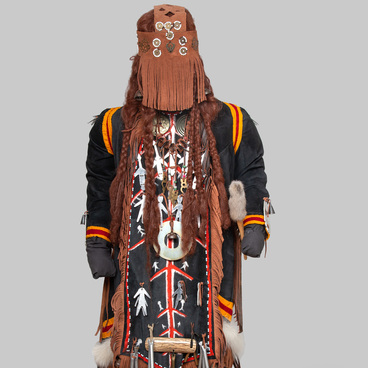The Nenets are a northern nomadic people. In their culture, every household item has a practical function. Some of the most popular attributes are “patku”, padded bags and deerskin sacks. They are used to store fur taken from the legs and head of a deer, blanks for sewing fur shoes, a supply of wood shavings and feathers.
Large bags are also used as pillows and insulation in the chum. Patku bags are sewn from two identical halves, often in the shape of a crescent. The front side of the bag is elegantly decorated, and the time of its manufacture can be determined by the complexity of the technique. Nenets decorative craft began with the collection of furs of various colors and progressed to embroidery with a checkerboard pattern and mosaic ornament. This is also evidenced by an old Nenets riddle about the bag: “an old woman from a hundred patches.”
Nenets bags come in several types in terms of size and purpose. The average size of fur bags is 40×60 cm. Paired straps are sewn along the mouth for tying, and the edges are trimmed with a strip of rovduga — buckskin. To store women’s things — shoes and underwear — the Nenets use bags, which are called “shupaty”. This is an important attribute of personal female property. In the chum, shupaty have a strictly designated place in the women’s half of the dwelling — on the edge of the bed in front of the entrance to the chum.
In small handbags of another type — tushany — the Nenets store handicraft accessories: needles, thimbles, shreds of fur, and tendon threads. Tushany are sewn from two oval cuts of fur, and the side seams are decorated with stripes of colored leather or cloth. Every Nenets girl learns how to sew at the age of seven and gets her own tushan bag to store her sewing items. Traditionally, this handbag accompanies a woman in a wedding caravan — it rides with the bride in the same sled. Nenets girls consider a handicraft bag to be their talisman and a friend with whom they can share all the secrets.
According to northern beliefs, it is forbidden to keep a handicraft bag empty, and it has its own patroness — nimi kata. The forest Nenets associate her image with a spider that endlessly weaves lace, just like a woman sews all her life to dress her family and keep them warm.
Nenets bags come in several types in terms of size and purpose. The average size of fur bags is 40×60 cm. Paired straps are sewn along the mouth for tying, and the edges are trimmed with a strip of rovduga — buckskin. To store women’s things — shoes and underwear — the Nenets use bags, which are called “shupaty”. This is an important attribute of personal female property. In the chum, shupaty have a strictly designated place in the women’s half of the dwelling — on the edge of the bed in front of the entrance to the chum.
In small handbags of another type — tushany — the Nenets store handicraft accessories: needles, thimbles, shreds of fur, and tendon threads. Tushany are sewn from two oval cuts of fur, and the side seams are decorated with stripes of colored leather or cloth. Every Nenets girl learns how to sew at the age of seven and gets her own tushan bag to store her sewing items. Traditionally, this handbag accompanies a woman in a wedding caravan — it rides with the bride in the same sled. Nenets girls consider a handicraft bag to be their talisman and a friend with whom they can share all the secrets.
According to northern beliefs, it is forbidden to keep a handicraft bag empty, and it has its own patroness — nimi kata. The forest Nenets associate her image with a spider that endlessly weaves lace, just like a woman sews all her life to dress her family and keep them warm.


